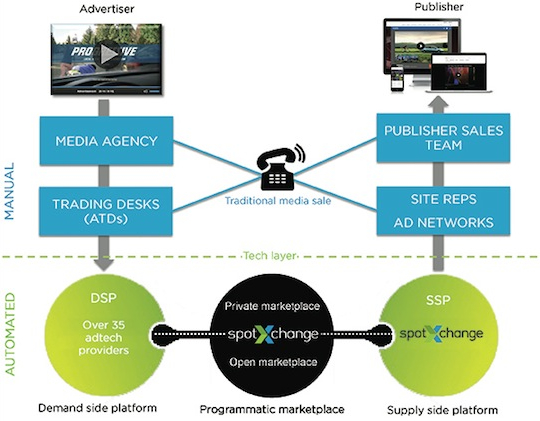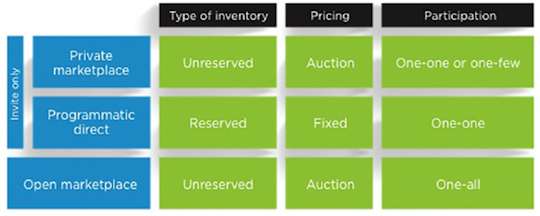The CMO’s guide to programmatic advertising
Share
 Chris Blok, SpotXchange director of demand, APAC, explains why programmatic advertising is another piece of marketing automation technology that marketers need to understand. This guide aims to demystify the complexities of programmatic technology.
Chris Blok, SpotXchange director of demand, APAC, explains why programmatic advertising is another piece of marketing automation technology that marketers need to understand. This guide aims to demystify the complexities of programmatic technology.
To date, programmatic advertising has largely been seen as falling outside the marketer’s remit. An adland buzzword, it’s been viewed as a buying mechanic marketers didn’t need to know about.
This belief is already outdated, for a number of reasons.
The first is fragmentation. Marketers need to reach consumers across multiple channels, media and devices. Adjusting message based on user, context and device is a complicated task that only real-time automation can address.
Secondly, the explicit targeting capabilities of online advertising make it possible to personalise messages and track interaction, response and return on investment. The real-time insights generated enable marketers to tailor messages on the fly and re-evaluate their approach continuously in real time, rather than monthly or quarterly.
Which brings us to the third point – the integration of touch-points in a bid to create a single view of a customer. Digital ad strategy needs to plug into data management platforms (DMPs) and talk to other marketing automation systems to enable coordinated contact with customers and target markets.
In an age of automated, data-driven, real-time systems of engagement, as opposed to mass, push-based campaigns, programmatic advertising is an unavoidable reality for marketers. It’s just another piece of marketing automation technology.
So you know where I’m coming from, SpotXchange is an inventory management platform for publishers (supply-side platform, ad server, programmatic infrastructure, yield manager and reporting platform), and plays exclusively in the video space.
Here’s a quick guide to help marketers understand and get the most out of programmatic.
The basics
Programmatic refers to the automated sale of ad space – a process driven by an ecosystem of technology that sits between advertisers and publishers.
The technology can be used to either automate the full transaction, removing direct contact between media buyer and publisher, or to automate the workflow behind the sale once it has been negotiated by traditional sales staff (programmatic direct).
How does it work?
When a visitor lands on a webpage carrying an ad unit (‘inventory’), its publisher sends a request for an ad to a programmatic marketplace. The marketplace then returns an ad that matches the criteria specified by the advertiser – audience data, price and other deal terms. The ad selected is the winner of an auction between advertisers competing to serve their ad to the viewer – a process called real-time bidding (RTB). Marketplaces can be set up as open (all advertisers can participate) or private (publishers invite a handful of select advertisers to bid for their inventory).
Programmatic gives brands the opportunity to gain increased control and transparency, while also providing granular reporting and the ability to adjust campaigns in real-time.
The buy-side platform’s (DSP) dashboard enables users to see exactly which ad space they’re buying. It can be adjusted on an impression-by-impression basis, affording greater control and optimisation of performance.
Automating the buy also introduces operational efficiencies, superior targeting capabilities and greater inventory access. It’s possible to use a single platform to buy inventory across all formats and devices – display and video; desktop, mobile and tablet – and track results.
What can I do with data?
The trump card, though, is data. The system makes it possible for connected organisations to retarget website visitors, deploy ads based on first-party data or overlay third-party data to target market segments.
To bring some of these applications to life, lets look at a few examples.
You may be CommBank, with a remit of improving conversion on home loans. By connecting your data management platform to the programmatic pipeline, it’s possible to retarget visitors to the home loans section of your website, then can track if someone signs up for a home loan or responds in some other way after seeing an ad.
Companies such as Krux make this kind of integration possible, by tagging a site and deploying pixels to track users anonymously, then feeding that information into the programmatic system so that it knows which ad to serve to which person.
For marketers with a centralised CRM system, it’s possible to add offline and online first-party data as an additional layer on top of this. Data housing companies such as Krux, Lotame and Eyeota can assign anonymous unique identifiers to site logins to connect online and offline data. Ideally, your CRM data captures everything that’s on a drivers licence and pairs it with an anonymous identifier. Online and offline actions can then be followed up with an ad when that user lands on a publisher site, just like they can be followed up with an email.
The next step on from this is third-party data, which can be bought and overlaid into the programmatic platform. Say you want to target people who are interested in sport. Companies such as Eyeota have segmented data like this available from site affiliations, so in this example a tagged sport site that plants a cookie on a user so they can be retargeted as a sports fan.
The feedback from this system allows marketers to track return on investment on their spend, using attribution models to record cost per acquisition. Results can be attributed back to campaigns and dollar spend, giving transparent analytics on ROI.
In summary, programmatic gives advertisers the ability to cherry pick impressions based on demographic, behaviour, price and location, track ROI and interconnect marketing activity to deliver a coordinated voice to consumers.

















